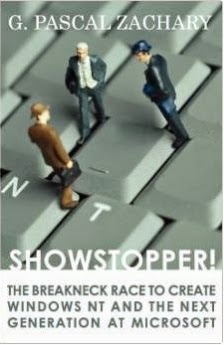 The book tells the great story of Dave Cutler, an OS architect at Digital Equipment Corp, whom Bill Gates wooed to come to Microsoft after DEC management decided not to pursue Cutler’s ideas for a next generation OS. Cutler had designed the PDP-11’s RSX-11M OS as well as the DEC VAX’s VMS OS and so was considered without-peer when it came to OS design and development. At the time, (1988) MS-DOS was all the rage, but Gates realized that for the personal computer to move forward and take advantage of cutting edge technologies such as the new Intel 386, it needed a “real” OS: something with preemptive multi-tasking, a flat memory model, security, multi-user capabilities, a journaling file system, etc. Dave Cutler, and the lieutenants he brought with him from DEC, delivered Windows NT, and this book tells the story.
The book tells the great story of Dave Cutler, an OS architect at Digital Equipment Corp, whom Bill Gates wooed to come to Microsoft after DEC management decided not to pursue Cutler’s ideas for a next generation OS. Cutler had designed the PDP-11’s RSX-11M OS as well as the DEC VAX’s VMS OS and so was considered without-peer when it came to OS design and development. At the time, (1988) MS-DOS was all the rage, but Gates realized that for the personal computer to move forward and take advantage of cutting edge technologies such as the new Intel 386, it needed a “real” OS: something with preemptive multi-tasking, a flat memory model, security, multi-user capabilities, a journaling file system, etc. Dave Cutler, and the lieutenants he brought with him from DEC, delivered Windows NT, and this book tells the story.The book reads like a software engineering version of Soul of a New Machine. It’s accessible to the general reader, but software developers will especially appreciate its stories. There is talk about the kernel, networking and graphics subsystems, user interface elements, debugging, documentation, plus tight deadlines, company politics, and fun personalities. Some of the people in the book who led the development effort for NT are still at Microsoft today! For example, S. Somasegar, and even Dave Cutler himself never left.
Mike Abrash
Finally the graphics group had something to crow about. People long had complained about the group’s sluggish gains in speed. They had all but given up hope of dramatic improvements. Then, as one teammate said, “a miracle happened: Mike Abrash.”Mike Abrash is still the go-to-guy for performance tuning as evidenced by this recent (2007) email from none other than id Software’s John Carmack.
An Ironic Comment
At one point the author is talking about the personality of Bill Gates. It’s ironic that he describes him this way:Which was the real Bill Gates? The richest American by virtue of his roughly seven billion dollars in Microsoft stock, Gates was an object of envy and awe, paranoia and adulation. These strong emotions made a balanced assessment of his actions impossible. Anyway, the choice between saint or sinner was an illusion; these were cartoon images of Gates. The real Gates resembled a big-city political boss; more Richard Daley than Rockefeller.Funny that Zachary calls him “more Richard Daley than Rockefeller”—I don’t think anyone would say that today, since Gates is devoting his fortune and time to philanthropy much the same way Rockefeller did! It’s a fact that Rockefeller spent a longer portion of his life in the philanthropy business than in the oil business. I think the same will be said of Bill Gates one day.
Crazy Editing
My copy of the book was published by a company called E-Reads, who weren’t the original publishers, and who also don’t seem to be in existence any more. Anyway, every so often throughout the book there are quirks to the layout, like newlines inserted in the middle of sentences. It doesn’t really take away from the story, but it is irksome.A real embarrassment is the back cover. The second sentence says “Driven by the legendary Bruce Cutler…”—the entire book revolves around DAVE Cutler, but on the dust jacket they call him Bruce! How did such an error escape notice? “Dave Cutler” is the protagonist and appears on virtually every page of the book, yet they messed up his name on the back cover! Anyway, it obviously doesn’t change the story of NT, but I thought it was worth pointing out.


Post a Comment
Be sure to select an account profile (e.g. Google, OpenID, etc.) before typing your comment!